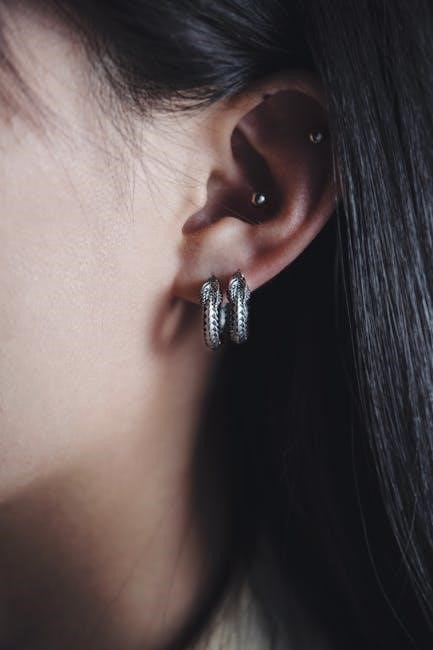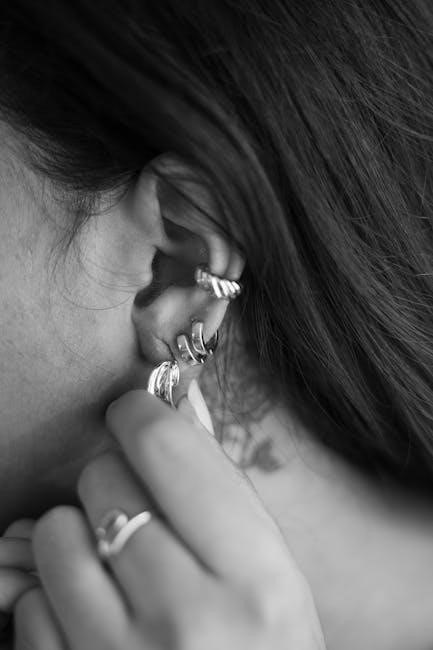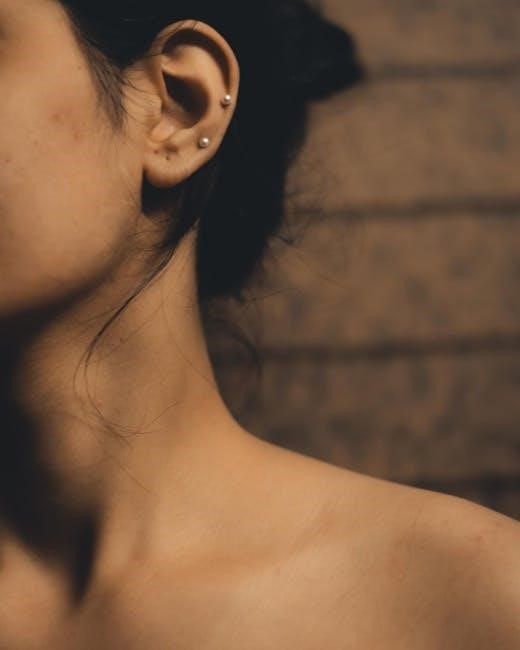Ear piercing is a timeless form of self-expression, offering endless possibilities for personal style. From lobe piercings to intricate cartilage designs, it’s a versatile way to enhance your look with minimal effort. With proper care and professional guidance, ear piercings can be a safe and rewarding experience, allowing you to curate a unique aesthetic that reflects your individuality.
Overview of Ear Piercing as a Form of Self-Expression
Ear piercing is a versatile and creative way to express personal style, allowing individuals to showcase their uniqueness through carefully curated designs. Whether it’s a delicate lobe stud or a bold cartilage ring, piercings offer endless opportunities for customization. This form of self-expression has become a cultural phenomenon, with trends like “earscaping” gaining popularity. By choosing specific placements and jewelry, individuals can mirror their personality, making ear piercing a timeless and empowering way to stand out. It’s a simple yet impactful method of storytelling through fashion.
Importance of Professional Piercing Services
Professional piercing services are essential for a safe and successful experience. Expert piercers use high-quality materials and sterile techniques to minimize risks and ensure proper healing. Studios like Studs and Rowan emphasize precision and hygiene, offering a trustworthy environment for first-timers and experienced individuals alike. Their expertise helps you avoid common mistakes, such as improper placement or low-quality jewelry, which can lead to complications. By choosing professionals, you invest in a positive experience and a beautiful, long-lasting result that enhances your personal style.
Brief History of Ear Piercing
Brief History of Ear Piercing
Ear piercing dates back thousands of years, with evidence of its practice found in ancient civilizations. The oldest known example is Ötzi the Iceman, whose mummified body revealed pierced ears. Historically, ear piercings held cultural, religious, and ceremonial significance, symbolizing status, spirituality, or beauty. Over time, they evolved into a global fashion trend, with modern styles like “earscaping” popularized by studios such as Studs and Rowan. This timeless art continues to be a universal form of self-expression and personal style.
Types of Ear Piercings
Ear piercings offer a wide range of styles, from classic lobe piercings to intricate cartilage designs. Popular options include helix, tragus, daith, and conch piercings, each with unique placements and aesthetics. Whether you prefer subtle studs or bold statement jewelry, there’s a piercing type to suit every style and preference. Understanding the differences in pain levels, healing times, and aftercare requirements can help you choose the perfect piercing to enhance your look and express your individuality.
Lobe Piercing
A lobe piercing is the most traditional and popular type of ear piercing, located at the soft, fleshy part of the earlobe. It is known for being the least painful due to the absence of cartilage. This piercing heals relatively quickly, typically within 6-8 weeks, and is suitable for all ages. The lobe is versatile, accommodating various jewelry styles, including studs, hoops, and drop earrings. Its simplicity and low maintenance make it an ideal choice for first-time piercees and those seeking a classic, timeless look. It’s a great starting point for building a curated ear aesthetic.
Helix Piercing
The helix piercing is located on the upper rim of the ear, offering a sleek and edgy aesthetic. It is considered more painful than a lobe piercing due to the cartilage. Healing typically takes 6-12 months, requiring diligent aftercare. This piercing is highly versatile, with popular jewelry options including studs, hoops, and rings. Its placement allows for creative styling, making it a favorite for those seeking a modern, bold look. Consulting a professional piercer is essential for proper placement and to ensure a smooth healing process.
Tragus Piercing
The tragus piercing is situated on the small flap of cartilage in front of the ear canal, adding a delicate touch to your ear aesthetic. It is known for its subtle appearance and moderate pain level, often described as a 5-7 on a 10-point scale. Healing typically lasts 4-12 months, requiring careful aftercare to prevent complications. This piercing is ideal for those seeking a understated yet stylish addition to their look, with popular jewelry choices including small studs and delicate hoops.
Daith Piercing
The Daith piercing is placed on the inner fold of cartilage just above the ear canal, offering a bold and edgy aesthetic. With a pain level of around 6-7/10, it requires precision due to its delicate location. Healing times range from 4-12 months, needing consistent aftercare to ensure proper recovery. Ideal for those seeking a striking look, the Daith piercing is often adorned with rings or studs, making it a popular choice for those wanting to add a unique touch to their ear styling.
Conch Piercing
The Conch piercing is located in the shell-shaped area of the ear, offering a striking visual appeal. It can be pierced on the inner or outer part of the conch, with the inner conch being more common. The pain level is moderate, around 5-7/10, due to the thickness of the cartilage. Healing times typically range from 6-12 months. This piercing is versatile, accommodating various jewelry styles like hoops or studs. However, proper sizing is crucial to ensure comfort and a clean look, making it a popular choice for those seeking a bold, eye-catching design.
Rook Piercing
The Rook piercing is a striking option located in the upper, inner rim of the ear, known for its edgy aesthetic. Positioned in the anti-helix area, it’s a popular choice for those seeking a bold, unique look. The pain level is moderate, around 6-8/10, due to the thickness of the cartilage. Healing times typically range from 9-12 months. Jewelry options include rings or stud earrings, with proper sizing essential for comfort. Aftercare is crucial to prevent complications, making this piercing a great choice for those who enjoy standout, less common designs.
Anti-Helix Piercing
The Anti-Helix piercing is located on the inner rim of the ear, opposite the helix, offering a unique and less common aesthetic. It’s known for its delicate appearance and moderate pain level, typically rated 7/10. Healing times range from 6-12 months, with proper aftercare essential to prevent complications. Suitable jewelry includes rings or studs, preferably in high-quality metals. This piercing is ideal for those seeking a subtle yet distinctive look, as it adds a touch of elegance without being overly bold. Its popularity has grown in modern piercing trends, making it a great choice for those exploring beyond traditional options.
Transverse Lobe Piercing
The Transverse Lobe piercing is a unique style that involves threading a barbell horizontally through the earlobe, creating a standout look. This piercing is ideal for those who want to add visual interest to their ear stack. Pain levels are moderate, similar to traditional lobe piercings, and healing times typically range from 6-8 weeks. Proper aftercare is crucial to avoid complications. Jewelry options include barbells or labret studs, which can be customized to suit personal style. This piercing has gained popularity for its modern and edgy aesthetic, making it a favorite among piercing enthusiasts looking to elevate their look with a distinctive touch.
Snug Piercing
The Snug piercing is located on the inner rim of the ear, just above the anti-helix, creating a delicate and subtle look. It’s a popular choice for those seeking a minimalist aesthetic. The piercing process involves careful precision due to the area’s tight curvature. Pain levels are moderate, as it’s a cartilage piercing, and healing times typically range from 3-6 months. Proper aftercare is essential to prevent complications. Small studs or rings are recommended for this piercing, which adds a touch of elegance to any ear stack while maintaining a versatile style.
Orbital Piercing
An Orbital Piercing features a ring that passes through two separate holes in the ear, creating a circular or “orbital” effect. This unique piercing is a striking choice for those seeking a bold, eye-catching look. Pain levels are higher due to the dual piercings, and healing times typically range from 6-12 months. Proper aftercare is crucial to avoid complications. Orbital piercings are often adorned with seamless rings or hoops, making them a standout addition to any curated ear style. This piercing is ideal for those looking to add a touch of edginess to their aesthetic.
Industrial Piercing
An Industrial Piercing involves two piercings connected by a single straight barbell, typically passing through the helix and anti-helix. This bold, edgy look is popular among those seeking a rugged aesthetic. Pain levels are moderate to high due to the cartilage, and healing times range from 6-12 months. Proper aftercare is vital to prevent complications. Industrial piercings are often styled with heavy-duty barbells or industrial bars, offering a unique, customizable look that appeals to those who embrace a more intense, alternative style.
Factors to Consider Before Getting an Ear Piercing
Consider placement, personal style, budget, and aftercare before getting pierced. Choose a reputable professional and ensure you’re prepared for the healing process and lifestyle adjustments.
Understanding Placement Options
Ear piercing placement is crucial for achieving your desired aesthetic. Popular options include the lobe, helix, tragus, daith, and conch, each offering unique visual appeal. Consider your face shape, personal style, and how the piercing will complement your features. Placement affects both the piercing’s appearance and healing process, so it’s essential to choose wisely. Use an ear piercing map to visualize options and discuss your preferences with a professional piercer to ensure the best fit for your anatomy and lifestyle.
Pain Levels Associated with Different Piercings
Pain levels vary significantly across ear piercings. Lobe piercings are generally the least painful, while cartilage piercings, like the helix or daith, may cause more discomfort. The tragus and rook piercings are known for being moderately painful, with a sharp, quick sensation. Pain is subjective, depending on individual tolerance. Most piercings are brief, lasting only a few seconds, and are manageable with proper preparation and aftercare. Consulting a professional can help you understand what to expect and make the experience smoother.
Healing Times for Various Piercings
Healing times for ear piercings vary depending on the type and location. Lobe piercings typically heal within 6-8 weeks, while cartilage piercings, such as helix or tragus, may take 4-12 months. Daith and rook piercings often require 6-10 months for full healing. Proper aftercare is essential to ensure the piercing heals smoothly and without complications. It’s important to wait until the piercing is fully healed before changing jewelry, as premature removal can lead to irritation or prolonged healing times. Individual factors, like skin type and care habits, can also influence healing duration.
Choosing the Right Jewelry for Your Piercing
Selecting the right jewelry for your ear piercing is crucial for both style and comfort. For new piercings, opt for high-quality, hypoallergenic metals like surgical stainless steel, titanium, or 14k gold to minimize irritation. Consider the piercing type: studs are ideal for lobes, while hoop earrings or rings suit helix or tragus piercings. Ensure the jewelry fits snugly but not too tight, allowing for proper airflow and healing. Choose sizes that complement your ear shape and personal style, balancing aesthetics with comfort for a flawless look.

Jewelry Options for Ear Piercings
Explore versatile jewelry options, from elegant studs and hoops to bold rings, designed to enhance your piercing. Choose hypoallergenic materials like surgical steel or gold for comfort and style.
Recommended Metals for New Piercings
For new piercings, hypoallergenic metals like surgical stainless steel, solid gold (14k or 18k), and platinum are highly recommended. These materials are gentle on the skin and reduce the risk of allergic reactions. Titanium is another excellent option, known for its biocompatibility and durability. Avoid sterling silver for fresh piercings, as it can cause irritation. Opting for high-quality metals ensures proper healing and minimizes discomfort. Always consult a professional to choose the best metal for your piercing needs.
Popular Jewelry Styles for Different Piercings
Ear piercings offer a wide range of jewelry options to suit every style. Studs and hoops are timeless choices for lobe piercings, while helix piercings often feature sleek barbells or minimalist rings. Tragus and daith piercings look stunning with delicate hoops or petite studs. For a bold look, industrial piercings can showcase longer barbells or eye-catching designs. Choosing the right jewelry enhances the piercing’s aesthetic, ensuring a look that’s both personal and polished. Experiment with styles to find the perfect match for your unique ear design.
Understanding Jewelry Sizes and Measurements
Choosing the right jewelry size is crucial for comfort and proper healing. Most ear piercings use standardized measurements, with gauge (thickness) and length (diameter) being key factors. Common gauges range from 18 to 20 for lobes and 16 to 14 for cartilage. Jewelry lengths vary, with shorter pieces suitable for helix and tragus piercings, while longer options work for lobe or industrial styles. Thread types, like push-back or screw-back, also matter for security and ease of use. Proper sizing ensures a snug, comfortable fit that promotes healing and prevents irritation.

Aftercare and Maintenance
Proper aftercare is essential for healing and preventing complications. Regular cleaning with saline solution and avoiding tight clothing can promote a smooth recovery. Consistent care ensures your piercing heals safely and looks its best. Maintain hygiene and follow professional advice to enjoy your piercing for years to come.
Proper Cleaning Techniques for New Piercings
Proper cleaning is crucial for healing. Use a saline solution (1/4 teaspoon of sea salt in 8 ounces of warm water) to gently clean the area 2-3 times daily. Avoid harsh chemicals like alcohol or hydrogen peroxide, as they can irritate the piercing. Pat dry with a clean towel; never rub. Avoid submerging the piercing in water, such as in baths or pools, until fully healed. Overcleaning can delay healing, so stick to the recommended routine. Professional advice can provide additional tailored care tips.
Signs of Infection and How to Prevent Them
Signs of infection include redness, swelling, increased pain, or discharge. To prevent infections, clean the piercing with saline solution daily, avoiding harsh chemicals. Keep the area dry and avoid touching it unnecessarily. Tight clothing can irritate the piercing, so opt for loose-fitting garments. If symptoms persist, consult a professional. Proper aftercare and using high-quality jewelry significantly reduce infection risks. Early detection and treatment are key to preventing complications. Always prioritize hygiene and follow recommended cleaning routines to ensure a smooth healing process.
Importance of Avoiding Tight Clothing
Tight clothing can irritate new ear piercings, causing discomfort and prolonging healing. Friction from tight fabrics can lead to swelling, redness, or even infection. Loose clothing reduces irritation, promoting a smoother recovery. Avoiding tight attire helps prevent accidental tugs or bumps, which can dislodge jewelry or damage the piercing site. Opting for breathable, non-restrictive fabrics minimizes risks and supports the healing process. Prioritizing comfort ensures your piercing heals properly and reduces the chance of complications.
The Piercing Process
Ear piercing involves a quick, precise procedure using sterile tools to create a clean hole for jewelry. Professionals ensure safety, hygiene, and minimal discomfort during the process.
What to Expect During the Piercing Procedure
During the piercing process, a professional will clean and mark the area to ensure precise placement. Using sterile tools, they create a small hole and insert the jewelry.
The procedure is quick, typically taking a few seconds, with minimal discomfort. Afterward, you’ll receive aftercare instructions to promote healing.
Professionals ensure a clean, safe environment, making the experience smooth and stress-free for first-time piercees. Proper preparation, like eating beforehand, can help avoid lightheadedness.
Preparing for Your Piercing Appointment
To ensure a smooth experience, arrive well-prepared. Eat a light meal and stay hydrated to avoid lightheadedness. Avoid alcohol or blood thinners beforehand.
Wear comfortable clothing that allows easy access to your ear. Research jewelry styles to discuss preferences with your piercer. Arrive early to complete paperwork and discuss any concerns. For minors, bring a parent or guardian for consent. Proper preparation ensures a safe and stress-free piercing process.
Post-Piercing Care Instructions
After your piercing, clean the area with a saline solution 2-3 times daily to promote healing. Avoid submerging the piercing in water, such as swimming, until healed.
Refrain from tight clothing that may irritate the area. Avoid playing with or removing the jewelry, as this can introduce bacteria. Monitor for signs of infection, such as redness or swelling, and consult a professional if concerns arise. Proper care ensures a smooth recovery and prevents complications.

Cost Considerations
Ear piercing costs vary based on location, piercer expertise, and jewelry quality. Prices range from $20 for lobes to $100+ for intricate cartilage piercings;
Average Prices for Different Types of Piercings
Ear piercing costs vary depending on the type and location. Lobe piercings typically range from $20 to $50, while cartilage piercings, like helix or tragus, can cost $40 to $100. More intricate piercings, such as daith or conch, may range from $80 to $150. Industrial piercings, involving multiple holes, can cost $100 to $200. Prices often include the piercing procedure and basic jewelry, but premium materials or custom designs may increase the total cost.
Factors That Affect the Cost of Piercings
The cost of ear piercings can vary based on several factors, including the type of piercing, the location, and the expertise of the piercer. High-end studios may charge more due to their reputation and hygiene standards. Additionally, the quality and material of the jewelry can significantly impact the price, with premium metals like gold or platinum costing more. Complex piercings, such as industrial or orbital styles, may also incur higher fees due to the precision and time required.
Maintaining and Upgrading Your Piercings
Maintaining piercings involves regular cleaning and avoiding tight clothing to prevent irritation. Upgrading jewelry can enhance the look, but wait until the piercing is fully healed to avoid complications.
When It’s Safe to Change Jewelry
It’s crucial to wait until your piercing is fully healed before changing jewelry to avoid complications. For lobe piercings, this typically takes 6-8 weeks, while cartilage piercings may require 4-12 months. Always consult a professional piercer to assess the healing progress and ensure it’s safe to swap jewelry. They can also help you choose the right size and type of jewelry for your piercing. Proper aftercare during the healing process is essential to ensure a smooth transition when upgrading or changing your jewelry.
How to Style Multiple Piercings
Styling multiple ear piercings is all about balance and personal flair. Start with a cohesive theme, like mixing minimalist studs with bold hoops, to create visual interest. Consider the placement of each piercing and how they interact visually. Pair delicate pieces in upper cartilage with statement earrings in the lobe for a curated look. Experiment with textures and metals to add depth, but ensure the overall design feels harmonious. Don’t be afraid to layer or contrast styles to reflect your unique aesthetic and make your ear piercings truly stand out.

Common Mistakes to Avoid
- Overcleaning can irritate the piercing and delay healing.
- Using low-quality jewelry increases the risk of infections and reactions.
- Touching the piercing frequently can introduce bacteria and cause complications.
Overcleaning and Its Effects
Overcleaning an ear piercing can lead to irritation, delaying the healing process. While keeping the area clean is essential, excessive use of cleaning products or harsh chemicals can strip the skin of its natural oils, causing dryness and discomfort. This can result in redness, swelling, or even infection. It’s important to follow a balanced aftercare routine, using saline solution as recommended by professionals. Avoid using alcohol, hydrogen peroxide, or antibiotic ointments, as these can exacerbate irritation. If signs of complications arise, consult a piercer or healthcare professional immediately.
The Dangers of Using Low-Quality Jewelry
Using low-quality jewelry for ear piercings can lead to allergic reactions, skin irritation, and delayed healing. Many inexpensive options contain nickel, a common allergen that can cause redness and discomfort. Poorly made jewelry may also have rough edges or improper threading, increasing the risk of infection or tissue damage. To ensure safety, opt for high-quality, hypoallergenic materials like surgical stainless steel, titanium, or solid gold. Always prioritize reputable sources to avoid complications and promote healthy healing for your piercings.
Why Tight Jewelry Can Be Problematic
Tight jewelry can restrict blood flow, causing discomfort and potentially leading to swelling or irritation. If the jewelry is too snug, it may embed into the skin, increasing the risk of infection or scarring. Additionally, tight jewelry can make cleaning more difficult, trapping bacteria and prolonging the healing process. It’s essential to choose jewelry that fits properly, allowing for a small amount of movement to ensure comfort and promote healthy healing. Always consult a professional to ensure the perfect fit for your piercing.
Cultural Significance of Ear Piercings
Ear piercings hold deep cultural and historical significance, serving as symbols of identity, spirituality, and status across civilizations. They transcend time, uniting tradition with modern self-expression.
Historical and Cultural Context of Ear Piercings
Ear piercings have been a cultural and spiritual practice for thousands of years, with evidence tracing back to ancient civilizations like Egyptians, Africans, and Indigenous cultures. They often symbolized status, spirituality, or rites of passage. In many traditions, piercings were used to signify wealth, marital status, or religious beliefs. The oldest known example is Ötzi the Iceman, dating back over 5,000 years. These practices have evolved into modern fashion, blending historical significance with personal expression, making ear piercings a timeless and universal form of human connection and identity.
Modern Trends in Ear Piercing Fashion
Modern ear piercing fashion emphasizes creativity and individuality, with trends like “earscaping” gaining popularity. This involves curating multiple piercings to create a personalized aesthetic. Minimalist studs and delicate hoops remain favorites, while bold styles, such as industrial and transverse piercings, offer edgy alternatives. Social media platforms like Instagram and Pinterest inspire users to experiment with unique placements and jewelry combinations. High-quality, hypoallergenic materials are now prioritized, catering to diverse budgets and styles, making ear piercings more accessible and fashionable than ever.
Ear piercing is a timeless form of self-expression, offering endless possibilities for personal style. With proper care and professional guidance, it’s a safe and rewarding experience, empowering you to embrace your individuality through unique, stylish designs.
Final Thoughts on Ear Piercing
Ear piercing is a personal and meaningful way to express your individuality. With so many styles and options available, it’s easy to find a piercing that reflects your unique aesthetic. Whether you prefer a classic lobe piercing or a bold cartilage design, the key to a positive experience lies in proper aftercare and professional guidance. Embrace the journey, explore your creativity, and enjoy the confidence that comes with curating your perfect ear look. Your ears are a canvas—make every piercing a statement of self-expression and personal style.
Encouragement to Explore Piercing Options
Exploring ear piercing options is an exciting journey of self-discovery. With countless styles and placements to choose from, you can create a look that truly represents you. Whether you’re considering a subtle lobe piercing or a bold cartilage design, remember that each piercing is an opportunity to express your unique personality. Don’t be afraid to experiment and seek inspiration from trends or professional advice. Your ears are a blank canvas—take the leap and transform them into a stunning reflection of your individuality and style.